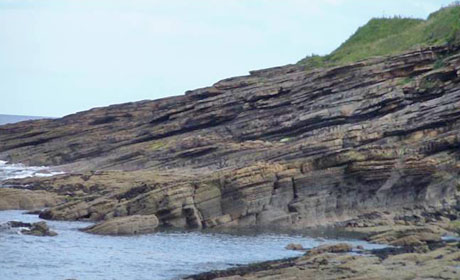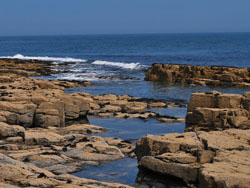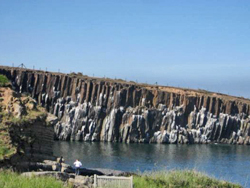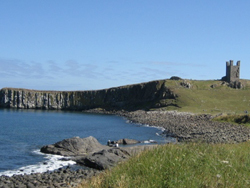Northumberland, England
 The People’s Choice
The People’s Choice
This is one of the most spectacular and accessible coastal sections in Northumberland, long used for excursions by students and amateur geologists. It is easy to follow the coast path, perhaps starting south of Craster at Longhoughton Steel or at Howick to see part of the Carboniferous section, followed by a walk over the Whin Sill to Craster village, completing the walk by progressing to the spectacular ruins of Dunstanburgh Castle.
There are plenty of places where the coast path can be accessed by road. The coast path is not tide dependent, but a traverse along the wave-cut platform requires low tide (and so it is perhaps best to use the coast path and drop down to the shore from time to time).
 The southernmost part of the section, Longhoughton Steel, is dominated by a coarse sandstone, the Longhoughton Grit which is analogous to the Millstone Grit further south. Abundant sedimentary textures indicate deposition in a river system flowing from the north-east.
The southernmost part of the section, Longhoughton Steel, is dominated by a coarse sandstone, the Longhoughton Grit which is analogous to the Millstone Grit further south. Abundant sedimentary textures indicate deposition in a river system flowing from the north-east.
Walking north (and down sequence), you encounter Yoredale-type cyclothems, with limestones providing the marker horizons. The general dip is easterly, and as the coast runs north-south the descent of the succession is perhaps rather subtle. But on the south side of the mouth of Howick Burn (NU258 163) there is an artesian borehole, put down by Farmer and Jones of Newcastle University in the 1960s to prove the succession. The water coming from the hole is fresh, with a faint smell of rotten eggs.
Further north, the fossiliferous Howick Limestone outcrops in Howick Haven, and this extends northwards to Rumbling Kern. Here, cliffs of massive coarse sandstone are a legacy of quarrying for building stone, creating a welcome sun-trap for visitors by providing shelter from easterly winds. There is abundant cross bedding in the sandstone, much convoluted representing distortion while the sediment was unconsolidated, and blocks of coal occur within the sandstone.
 The walk towards Cullernose Point crosses the Howick Fault, a major fault downthrown to the south. On crossing the fault the Acre Limestone is encountered, with abundant fossils.
The walk towards Cullernose Point crosses the Howick Fault, a major fault downthrown to the south. On crossing the fault the Acre Limestone is encountered, with abundant fossils.
The fault is intruded by one of the feeders to the Whin Sill, which dominates to the north where it forms the prominent, strongly jointed, cliffs of Cullernose Point. A thin dolerite dyke runs across the foreshore, and is visible at low tide. The cliffs here provide crowded nesting sites for seabirds. They also show signs of irresponsible coring, with outcrops of limestone damaged by thoughtless drillers.
Walking from Cullernose Point to the village of Craster, the path crosses the upper surface of the Whin Sill, and the coastal erosional surface allows many features of the sill to be seen. Craster itself is famous for its kippers; there is a large car park in a former dolerite quarry at the entrance to the village. Continuing north from Craster, the path continues across fields with the Whin Sill forming the coastal erosional surface and with Dunstanburgh Castle (dating from 1314; English Heritage and National Trust) acting as a magnet for the visitor.
 The approach to the castle crosses faulting that displaces the Whin Sill; entry to the castle is rewarded by superb views of the base of the Whin Sill from both the northern ramparts and the cliffs outside the castle, and further afield the Cheviot and Fell Sandstone hills of Northumberland.
The approach to the castle crosses faulting that displaces the Whin Sill; entry to the castle is rewarded by superb views of the base of the Whin Sill from both the northern ramparts and the cliffs outside the castle, and further afield the Cheviot and Fell Sandstone hills of Northumberland.
Dunstanburgh Castle itself has to be one of the most evocative and interesting castles in this country, irrespective of the splendour of its geological setting!
Text courtesy of Professor David Manning
Nominated by Kamil Nieciecki, St Benet Biscop Catholic High School, Bedlington, Northumberland